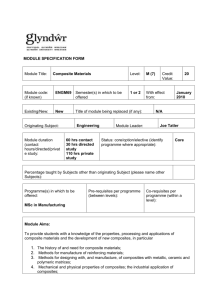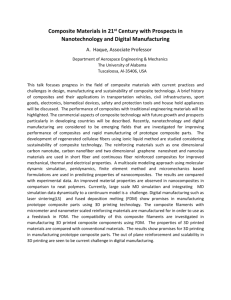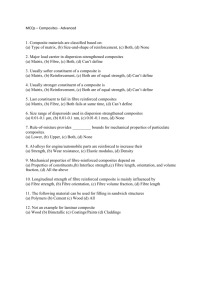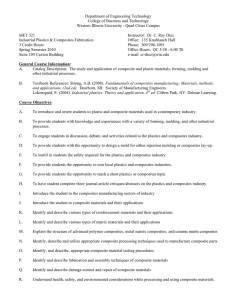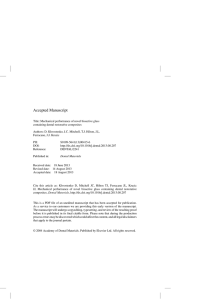Properties And Processing Of Composites
advertisement
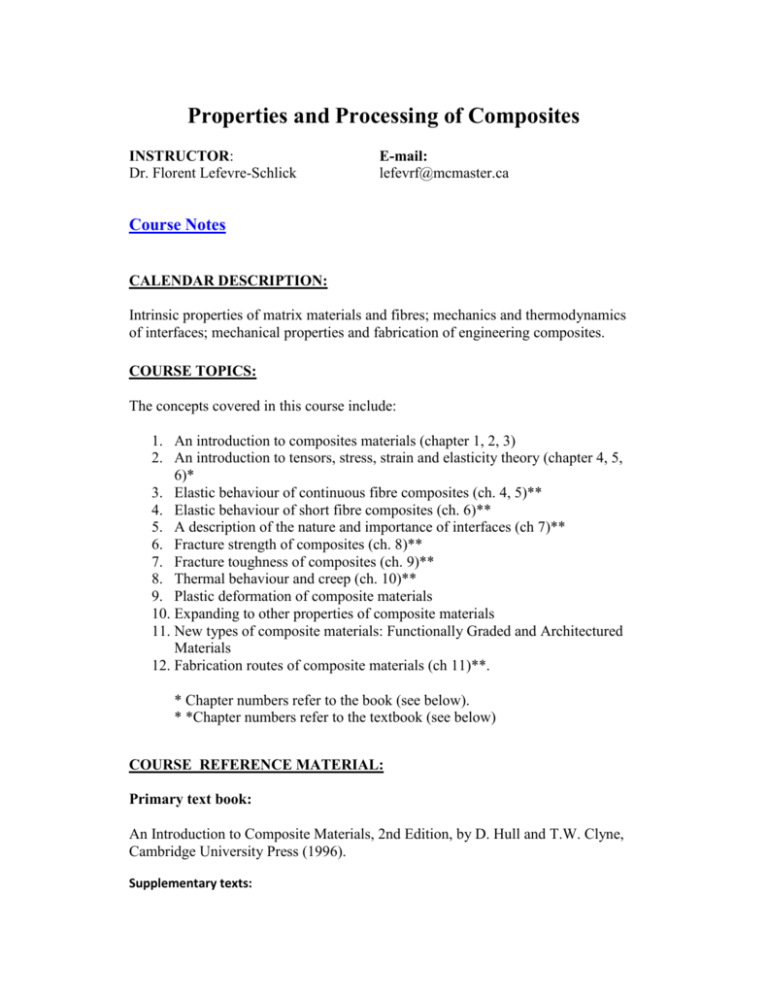
Properties and Processing of Composites INSTRUCTOR: Dr. Florent Lefevre-Schlick E-mail: lefevrf@mcmaster.ca Course Notes CALENDAR DESCRIPTION: Intrinsic properties of matrix materials and fibres; mechanics and thermodynamics of interfaces; mechanical properties and fabrication of engineering composites. COURSE TOPICS: The concepts covered in this course include: 1. An introduction to composites materials (chapter 1, 2, 3) 2. An introduction to tensors, stress, strain and elasticity theory (chapter 4, 5, 6)* 3. Elastic behaviour of continuous fibre composites (ch. 4, 5)** 4. Elastic behaviour of short fibre composites (ch. 6)** 5. A description of the nature and importance of interfaces (ch 7)** 6. Fracture strength of composites (ch. 8)** 7. Fracture toughness of composites (ch. 9)** 8. Thermal behaviour and creep (ch. 10)** 9. Plastic deformation of composite materials 10. Expanding to other properties of composite materials 11. New types of composite materials: Functionally Graded and Architectured Materials 12. Fabrication routes of composite materials (ch 11)**. * Chapter numbers refer to the book (see below). * *Chapter numbers refer to the textbook (see below) COURSE_REFERENCE MATERIAL: Primary text book: An Introduction to Composite Materials, 2nd Edition, by D. Hull and T.W. Clyne, Cambridge University Press (1996). Supplementary texts: S. Suresh and A. Mortensen, Fundamentals of Functionally Graded Materials K.K. Chawla, Composite Materials A. Kelly and N. H. MacMillan, Strong Solids F. A. McClintock and A. S. Argon, Mechanical Behaviour of Materials R. J. Young and P. A. Lovell, Introduction to Polymers M.R. Piggott, Load Bearing Fibre Composites (not in library, I have a copy) M.F. Ashby and D.R.H. Jones, Engineering Materials 2 L. Gibson and M.F. Ashby, Cellular Solids T.W. Clyne and P. J. Withers, Introduction to Metal Matrix Composites A. Kelly, Fabrication of Composites *A. Kelly and G.W.Groves, Crystallography and Crystal Defects. EVALUATION: Weekly quizz 10% Assigned homework: 20% Mid-term test: 20% Group project & presentation (4-5 students/group): 20% Final exam: 30% Final group project will involve the following elements: - pick an application for which composites are a likely candidate - develop in depth report which addresses: - possible materials systems - rational selection of materials - detailed design of composite architecture - analysis of micro-mechanics including (if important): elasticity limits, fracture toughness properties, fatigue properties, fracture, etc... Projects will be presented orally and in written form and it should be optimized for the presentation of about 20 minutes. There will be six groups of 4-5 students per group. Team work will be judged as well. COURSE OBJECTIVES: At the conclusion of this course, the student should have: 1. Develop knowledge of: o o o o o o Composite materials - what are they and how do they differ from other classes of materials? Nature of reinforcing materials - fibres, whiskers, platelets, etc. Overview of mechanical and physical properties of a range of composite materials systems Mechanisms of composite deformation and fracture Fabrication of composite materials, and how this relates to microstructure and properties How new materials are developed and become accepted by industry 2. Develop skills in: o o o o o o Assessment of the applicability of a specific material for a specific application Rational selection of materials Mechanics analysis of composite materials Self-directed learning, incorporating researching properties of commercial materials Reporting and presentation of information Industrial/manufacturing approach to applying technical knowledge RELEVANCE TO OTHER COURSES: This course can be considered a capstone experience in that it allows the student to apply much of the knowledge gained in previous course related to solid mechanics, mechanical behaviour of materials, microstructure and processing. Students are reminded of the following Policies, which would be relevant to activity in this course: Adverse Discrimination: The Faculty of Engineering requires all course outlines to include the following reminders: The Faculty of Engineering is concerned with ensuring an environment that is free of all adverse discrimination. If there is a problem that cannot be resolved by discussion among the persons concerned, individuals are reminded that they should contact their Department Chair, the Sexual Harassment Officer or the Human Rights Consultant, as soon as possible. Academic Dishonesty Policy "Academic dishonesty consists of misrepresentation by deception or by other fraudulent means and can result in serious consequences, e.g. the grade of zero on an assignment, loss of credit with a notation on the transcript (notation reads: "Grade of F assigned for academic dishonesty"), and/or suspension or expulsion from the university. It is your responsibility to understand what constitutes academic dishonesty. For information on the various kinds of academic dishonesty please refer to the Academic Integrity Policy, specifically Appendix 3, located at http://www.mcmaster.ca/senate/academic/ac_integrity.htm The following illustrates only three forms of academic dishonesty: 1. Plagiarism, e.g. the submission of work that is not one's own or for which other credit has been obtained. (Insert specific course information, e.g. style guide) 2. Improper collaboration in group work. (Insert specific course information) 3. Copying or using unauthorized aids in tests and examinations. (If applicable) In this course we will be using a software package designed to reveal plagiarism. Students will be required to submit their work electronically and in hard copy so that it can be checked for academic dishonesty." Updated January 1, 2013

